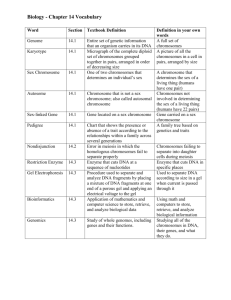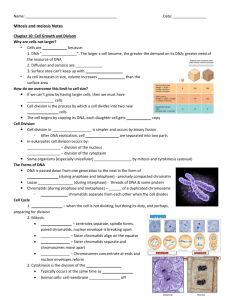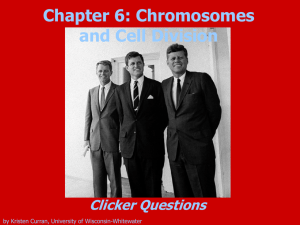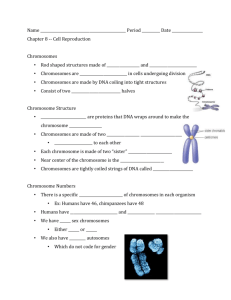biology_chapter_6_notes
advertisement
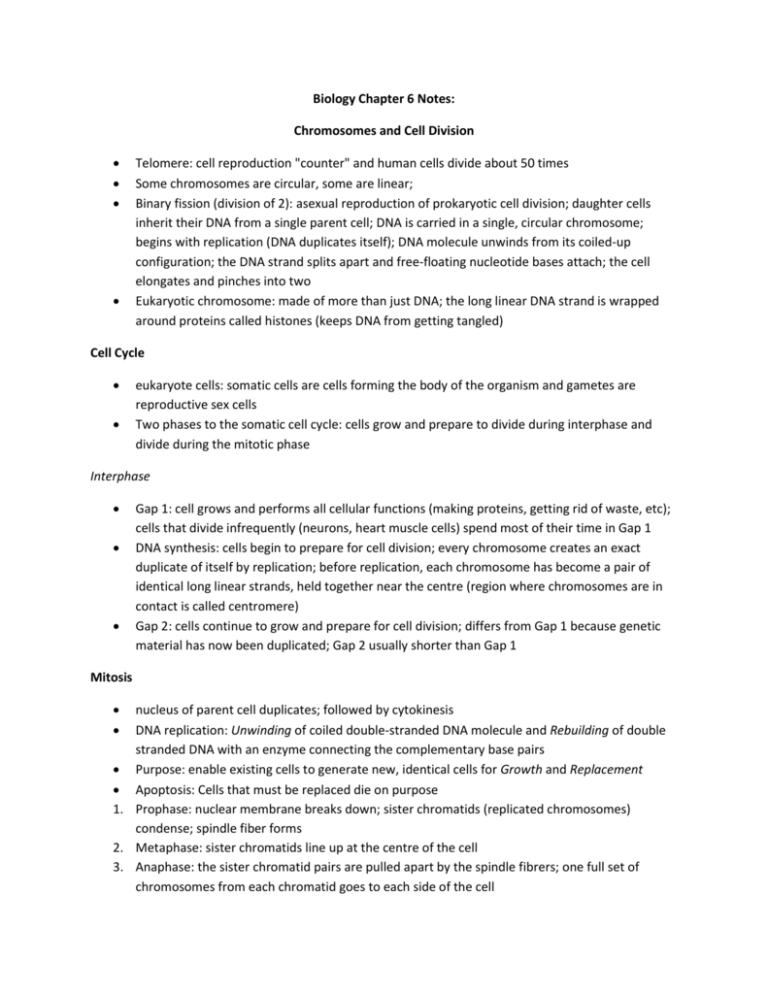
Biology Chapter 6 Notes: Chromosomes and Cell Division Telomere: cell reproduction "counter" and human cells divide about 50 times Some chromosomes are circular, some are linear; Binary fission (division of 2): asexual reproduction of prokaryotic cell division; daughter cells inherit their DNA from a single parent cell; DNA is carried in a single, circular chromosome; begins with replication (DNA duplicates itself); DNA molecule unwinds from its coiled-up configuration; the DNA strand splits apart and free-floating nucleotide bases attach; the cell elongates and pinches into two Eukaryotic chromosome: made of more than just DNA; the long linear DNA strand is wrapped around proteins called histones (keeps DNA from getting tangled) Cell Cycle eukaryote cells: somatic cells are cells forming the body of the organism and gametes are reproductive sex cells Two phases to the somatic cell cycle: cells grow and prepare to divide during interphase and divide during the mitotic phase Interphase Gap 1: cell grows and performs all cellular functions (making proteins, getting rid of waste, etc); cells that divide infrequently (neurons, heart muscle cells) spend most of their time in Gap 1 DNA synthesis: cells begin to prepare for cell division; every chromosome creates an exact duplicate of itself by replication; before replication, each chromosome has become a pair of identical long linear strands, held together near the centre (region where chromosomes are in contact is called centromere) Gap 2: cells continue to grow and prepare for cell division; differs from Gap 1 because genetic material has now been duplicated; Gap 2 usually shorter than Gap 1 Mitosis nucleus of parent cell duplicates; followed by cytokinesis DNA replication: Unwinding of coiled double-stranded DNA molecule and Rebuilding of double stranded DNA with an enzyme connecting the complementary base pairs Purpose: enable existing cells to generate new, identical cells for Growth and Replacement Apoptosis: Cells that must be replaced die on purpose 1. Prophase: nuclear membrane breaks down; sister chromatids (replicated chromosomes) condense; spindle fiber forms 2. Metaphase: sister chromatids line up at the centre of the cell 3. Anaphase: the sister chromatid pairs are pulled apart by the spindle fibrers; one full set of chromosomes from each chromatid goes to each side of the cell 4. Telophase: chromosomes begin to uncoil; nuclear membrane is reassembled around them 5. Cytokinesis: cytoplasm and organelles duplicate and are divided into approximately equal parts Out of Control Cell Division Cancer: unrestrained cell growth and division and can cause serious health problems Loses their "contact inhibition" Cancer cells can divide indefinitely Benign vs. malignant; metastasis is the process cancer cells separate from a tumor and invade the circulatory system Meiosis Fertilization: fusion of two reproductive cells Outcomes: 1. Reduces the amount of genetic material in gametes 2. Produces gametes that differ from one another with respect to the combinations of alleles they carry Gametes produced in a human's gonads; maternal and paternal copies of a chromosome are called homologous pair Homologues: Sister chromatids are connected by a centromere during the replication of a homologues Meiosis Division I 1. Prophase I: chromosomes condense and crossing over occurs; spindle is formed; homologous pairs of sister chromatids come together and cross over; nuclear membrane disintegrates 2. Metaphase I: homologues move towards the center of the cell and line up 3. Anaphase I: homologues separate and are pulled to opposite poles; sister chromatids going to each side are a mix of maternal and paternal genetic material 4. Telophase I and Cytokinesis: sister chromatids arrive at the cell poles and the nuclear membrane reassembles around them; the cell pinches into two daughter cells; chromosomes may unwind slightly Meiosis Division II 1. Prophase II: Chromosomes in daughter cells condense 2. Metaphase II: Sister chromatids line up at the centre of the cell 3. Anaphase II: sister chromatid pairs are pulled apart by the spindle fibers toward opposite cell poles 4. Telophase II and Cytokinesis: two daughter cells pinch into four haploid daughter cells; nuclear membrane reassembles around the chromosomes Female Gametes genetic material is divided evenly but cytoplasm goes to mainly one cell; there is only 1 gamete at the end of the two meiosis stages Sex of the Offspring Female gametes only have an X chromosome; females have XX chromosomes while males have XY chromosomes Birds: Female can either have W or Z chromosome gamete; male only has Z chromosome Ants, Bees, Wasps: sex is determined by the number of chromosome sets an individual possesses Turtles: high tempt usually leads to females; lower tempt usually leads to males Karyotypes a visual display of a complete set of chromosome: obtain some cells from the individual --> encouraged to divide by culturing them in a test tube --> divided cells are treated with a chemical that stops them exactly midway through cell division --> cells placed on microscope slide and a stain is added that binds the chromosomes to make them visible --> arranged by size and shape and displayed on a monitor or in a photograph nondisjunction: unequal distribution of chromosomes during meiosis; results in gametes having zero or two copies of a chromosome rather than a single copy Disorders 1. Turner syndrome: missing sex chromosome X _; short height, web of skin between neck and shoulders, underdeveloped ovaries, some learning difficulties 2. Klinefelter syndrome: extra X chromosome XXY; underdeveloped testes, lower testosterone levels, development of some female features, long limbs and slightly taller than average 3. Super males: XYY; taller than average, moderate to severe acne, slightly lower than average intelligence 4. Metafemale: XXX; may be sterile, no obvious phsyical or mental problems

